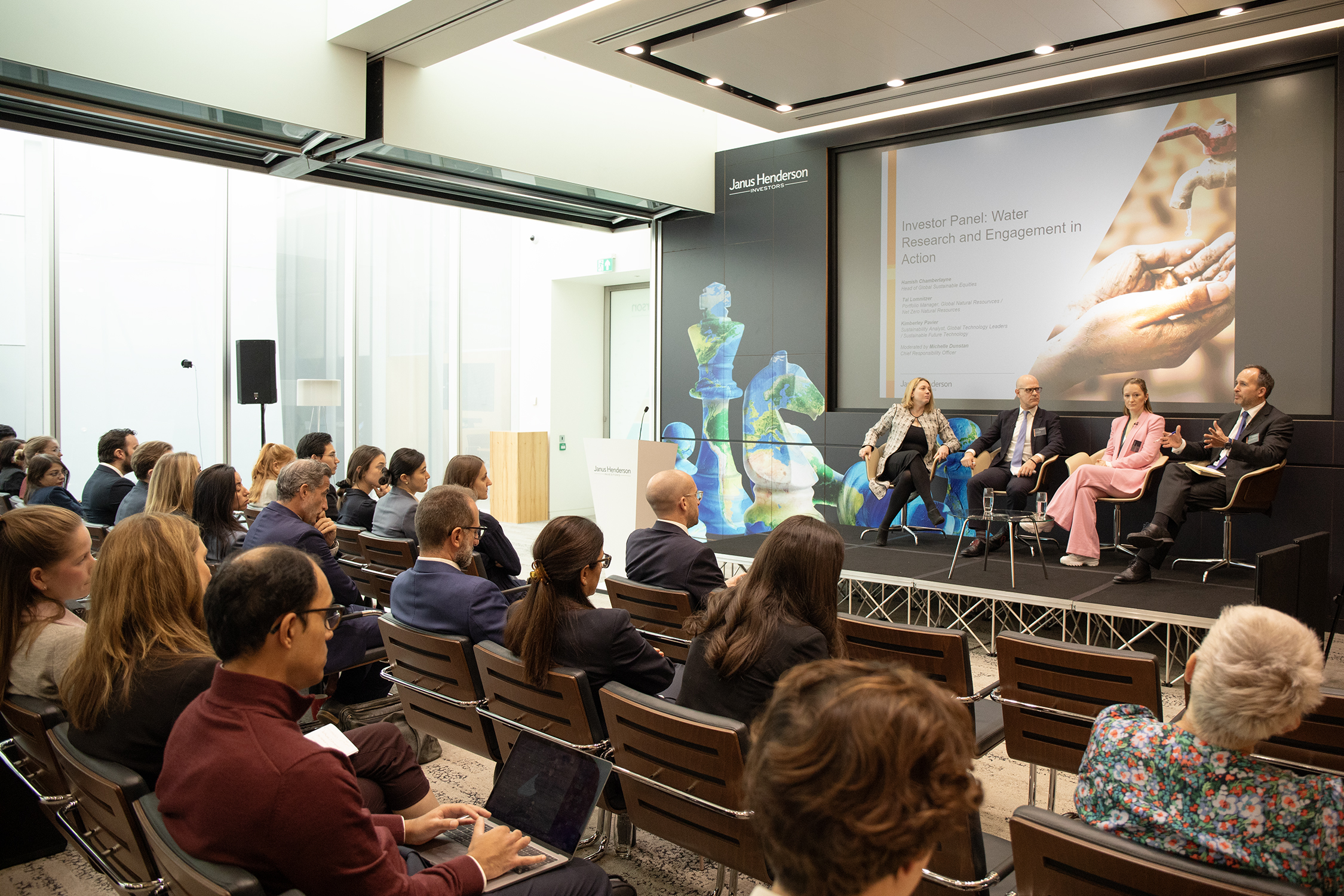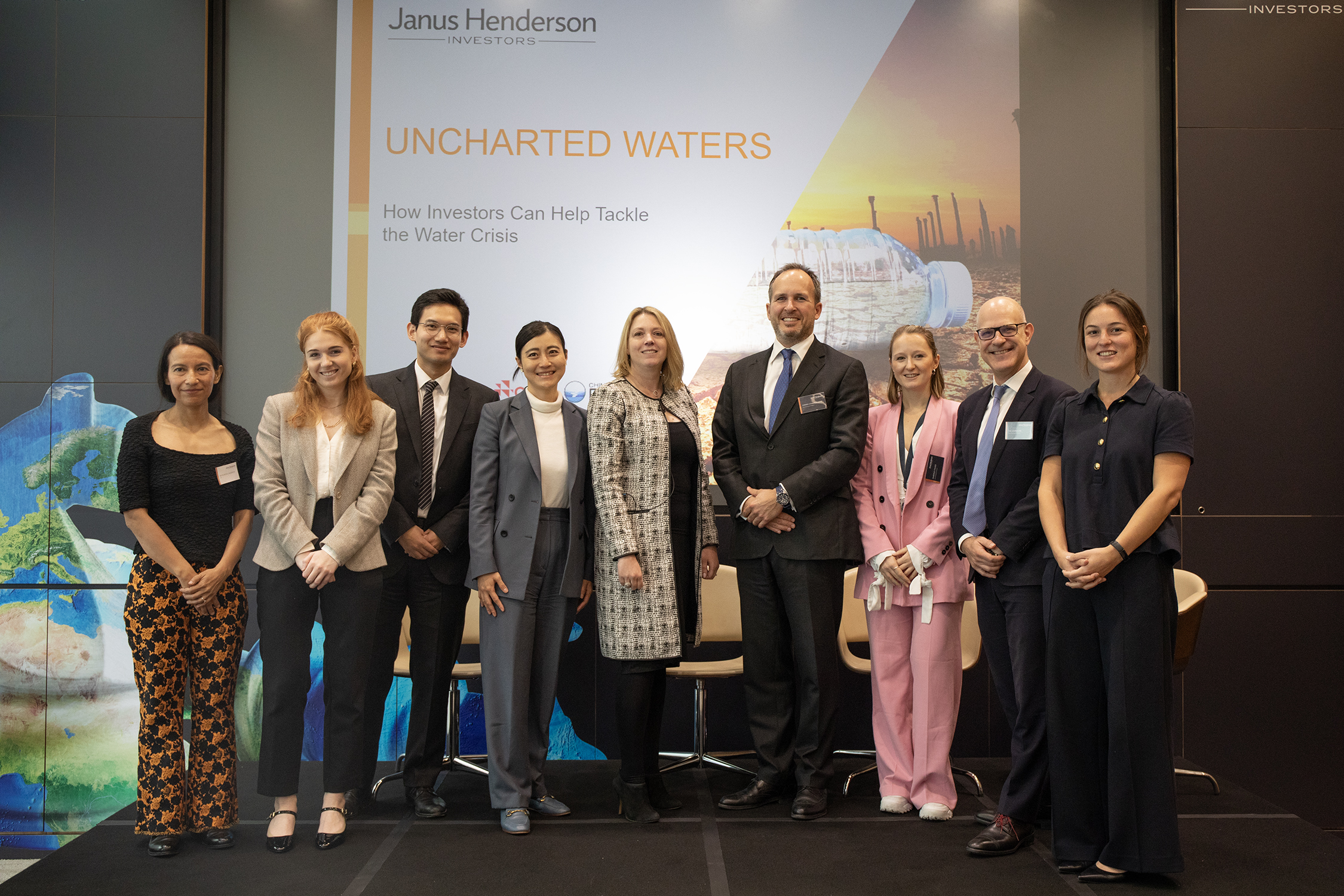Uncharted waters: How investors can help tackle the water crisis
Janus Henderson recently hosted the ‘Uncharted Waters’ conference exploring water scarcity and the associated implications for investors. This article summarises the key points discussed.
8 minute watch
Key takeaways:
- On current trends, the UN predicts a 40% global shortfall in water supply by 2030, driven by growing global demand and climate change.
- The water crisis is impacting companies across water-intensive sectors, including food and beverages, mining, and semiconductors.
- Deep research of companies and their supply chains, along with proactive engagement, can help investors mitigate water risks and benefit from opportunities associated with improved water efficiency.
In October 2023, Janus Henderson hosted the ‘Uncharted waters’ conference exploring water scarcity and the associated implications for investors. Analysts from Janus Henderson’s Responsible Investment and Governance team discussed their research of water-intensive sectors (sectors that use the most water) and the impact of growing water scarcity on businesses. Portfolio managers and analysts from Janus Henderson funds spoke to the importance of differentiated research and engagement with companies to address water risks. Experts from CDP (formerly Carbon Disclosure Project) and China Water Risk also shared insights on the causes, impacts, and evolution of the global water crisis.
Water security has long been a critical global challenge. Recent years have seen accelerating population growth and economic activity, driving demand for our planet’s most precious resource to unprecedented – and unsustainable – levels. Worsening climate change is expected to put additional strain on global water supplies. If current trends continue, by 2030, the UN predicts a 40% global shortfall in freshwater where demand outstrips supply.
While investor awareness of the need to curb greenhouse gas emissions has intensified in recent years, more attention is needed to tackle today’s acute water challenges. As Dr Patricia Calderon, water security specialist at the international non-profit, CDP, succinctly explains: “The water crisis is coming closer to our businesses, our communities and our homes”.

Accelerating water demands
Water scarcity poses significant risks across several industries. Some of these are unsurprising, like agriculture, and food and beverages, but other industries including mining and semiconductors are more exposed to water risks than some may think. Take the alcoholic beverage industry – in a typical bottle, water makes up almost 90% of beer and 60% of spirits. But factoring in processes like bottle washing, refrigeration, and grain steaming, the water intensity is even greater—up to 8 litres of water is required to produce just one litre of beer. Yet even this amount is small compared with the amount of water used to grow the grains used to make beer – over 90% of beer’s water footprint lies within the agricultural supply chain. In addition to its extensive water usage, this industry is highly susceptible to supply chain disruptions, as heightened risks of droughts and floods exert a long-term impact on the cost and availability of essential crops.
The mining sector is the second most water-intensive industry after utilities. As demand accelerates for metals essential to the energy transition, the mining industry’s water usage is expected to increase even further. Alarmingly, a fifth of all mines analysed by Trucost are situated in regions facing extreme water stress, while 27% are in areas where water risk is predicted to escalate. For example, Chile, which accounts for nearly one-third of the global copper supply, faces chronic drought conditions.
Semiconductor manufacturing is also incredibly water-intensive, with the production process requiring 264 billion gallons annually – equivalent to the annual water consumption of all households in London. Approximately half of the manufacturing steps necessitate “ultra-pure” water for operations like cleaning and cooling – a process requiring 1.5 litres of regular water to produce one litre of acceptably pure water. The semiconductor industry is projected to reach $1trn in revenue by 2030, driven by the rise of electrification, advanced computing, and automotive electronics, which will all increase the demand for water. Furthermore, water usage per semiconductor is also growing due to factors including more advanced node processes requiring more layers to be washed. Without innovation, this could mean exponential growth in water consumption for the industry.
To put into context the risks to the global economy, the International Food Policy Research Institute suggests current business-as-usual water management practices and levels of water productivity could threaten 45% of global GDP in 2050. This figure is forecasted to be US$63trn, equivalent to 1.5 times the size of the current global economy.
 Evaluating risks and opportunities
Evaluating risks and opportunities
A panel discussion with members of Janus Henderson’s investment teams revealed an awareness of water risks, but also the investment opportunities associated with better data and analytics. Hamish Chamberlayne, Global Sustainable Equity portfolio manager, notes that his strategy lacks exposure to visible water risk – as it excludes high-impact industries like agriculture or mining. Nevertheless, he is conscious of the complex multifaceted risks surrounding water, including waste management.
“The chemicals involved in semiconductor production have been a major area of focus for us over the last year,” Chamberlayne explains. “We aim to understand the amount of hazardous waste and pollution to which companies are exposed, as we are seeing major controversies that can have a significant financial impact.”
Given the pervasiveness of water risk factors across industries, proactive investor engagement is becoming imperative argues Tal Lomnitzer, senior investment manager on Janus Henderson’s Global Natural Resources team. “Investment tools like spreadsheets are adequate for looking at traditional financial risk, but when it comes to non-traditional risk, there is no substitute for a hard hat and steel-toed boots and getting down to a site.”
In addition to on-the-ground impressions, Lomnitzer believes some of the best insights about a company can often be discovered beyond the polished narratives offered by corporate executives. Here, Lomnitzer seeks to obtain the perspectives of a broader cross-section of the community, including local workers, taxi drivers and hoteliers, as well as local governments and regulators. These insights can be used in our engagements for action, where we encourage companies to take specific action in the best interest of its long-term sustainable cash flows.
In terms of opportunity, Kimberley Pavier, sustainability analyst on the Global Technology Leaders team at Janus Henderson Investors, is excited by the prospects of more comprehensive and detailed data – particularly as there remains a significant knowledge gap regarding water infrastructure and ocean ecosystems.
To navigate the complexities associated with water and ocean-based projects, Pavier expects increased deployment of digital tools and data analytics – such as sensors, satellite imagery, and artificial intelligence tools. She believes these instruments can help unlock opportunities in the ocean economy, which is estimated to grow from $1.5trn to $3trn by 2030.
While investors are beginning to think more about water – both in terms of risks and opportunities – the tide is set to only rise in the years ahead. Michelle Dunstan, chief responsibility officer at Janus Henderson Investors, summarises: “A lot of investors are late to the game because they have been focusing on carbon, and biodiversity and natural capital – but water is coming.”

Our ESG integration approach: Thoughtful, practical, research-driven and forward-looking
Source: Janus Henderson as at 17 October 2023.
These are the views of the author at the time of publication and may differ from the views of other individuals/teams at Janus Henderson Investors. References made to individual securities do not constitute a recommendation to buy, sell or hold any security, investment strategy or market sector, and should not be assumed to be profitable. Janus Henderson Investors, its affiliated advisor, or its employees, may have a position in the securities mentioned.
Past performance does not predict future returns. The value of an investment and the income from it can fall as well as rise and you may not get back the amount originally invested.
The information in this article does not qualify as an investment recommendation.
There is no guarantee that past trends will continue, or forecasts will be realised.
Marketing Communication.